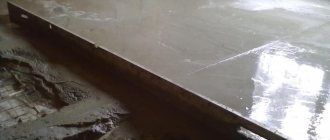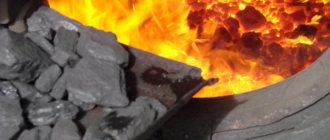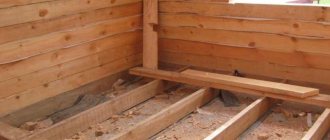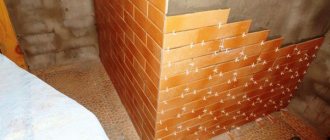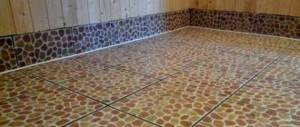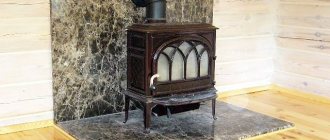Laying floor tiles in a bathhouse is practically no different from work in any other room. All features are a special adhesive composition and grout for seams. These components must have water-repellent characteristics and be able to withstand temperature changes and exposure to aggressive environments. There is one more feature - a slight slope towards the drain, but this is rather a feature of the floor, although this should not be forgotten during finishing work.
Important! Before laying the tiles, the floors in the steam room and washing room should already have a slope towards the drain. The surface must be flat. When pouring concrete screeds, you can use guide rails - this way you can ensure the required slope. When laying tiles on a surface that is not properly prepared, the adhesive consumption will increase significantly. Moreover, on a thick layer of glue, the tile will “float”, which will create additional difficulties when laying it.
The process of laying tiles in a steam room. Please note that the base for the metal stove is made approximately 50 mm higher than the main floor
The tiles for the floor in the bathhouse should be matte with a rough surface so that they do not slip. Its base should be non-porous so that it does not absorb moisture (in relation to the dressing room, you can choose any tile with a rough surface, since the humidity in the dressing room is low).
There are several more selection criteria - frost resistance and abrasion resistance, but whether you need to take these parameters into account depends on the type of bathhouse (all-season or not, how many people there will be, how often it will be visited, etc.). The sizes of ceramic tiles can vary, as can the shape, but it is easier to work with medium-sized square or rectangular tiles.
Tool
To lay the tiles we will need:
- Building level;
- Notched spatula (tooth height 8-9 mm);
- Drill with a nozzle for mixing glue;
- Plastic crosses;
- Device for cutting tiles (tile cutter).
In principle, ceramic tiles can be cut with a glass cutter, but it is still better to purchase a tile cutter. Tile cutters are either electric or manual. If you plan to limit yourself to laying tiles only in the bathhouse, then a manual tile cutter will be sufficient.
To learn how to choose a manual tile cutter, watch the video.
Features of the use of fire-resistant adhesive mixtures
Diluted tile adhesive must be used in accordance with certain recommendations, namely:
- Before applying the solution, the rough base should be cleaned of dust and dirt. This will ensure better adhesion of the glue to the surface;
- During work, it is advisable to use a respirator and safety glasses to prevent the possibility of the adhesive composition getting on the mucous membranes;
- Apply the mixture using a metal spatula with teeth. The height of the teeth directly depends on the caliber of the tile: the larger the area of the tile, the longer the teeth should be;
- Before laying the tiles, it is recommended to briefly dip the tiles in water to improve adhesion to the adhesive solution.
What glue to use to glue tiles in a bathhouse
Any hardware store will offer you various adhesive compositions. First of all, dry mixtures (sold in bags) and ready-made mixtures (in buckets) are separated. Ready-made mixtures are significantly more expensive, but when diluting dry mixtures there is a possibility of making mistakes with dosages.
If you are planning to make a heated floor in a bathhouse, then it is better to buy the glue recommended for laying heated floors:
- Has antiseptic properties;
- Environmentally friendly;
- Thermal and moisture resistant.
Ready-made NEOMID tile adhesive - 10 kg is enough for gluing up to 20 square meters of tiles.
Suitable for laying heated floors When choosing an adhesive, first of all you need to pay attention to the characteristics:
- Moisture resistance;
- Good tolerance to temperature changes and aggressive environments;
- Frost resistance - relevant in cases where the temperature in the bathhouse drops below zero.
Typically, dry two-component mixtures based on polyurethane or epoxy resin meet these requirements.
Advice! Two-component compositions remain elastic for about an hour after dilution, so prepare the glue in small portions.
You can use waterproof adhesive “Diola D-307”, which is intended for gluing heavy ceramic tiles to floors and walls indoors and outdoors.
Dry mixtures can also be used when laying floor tiles in a bathhouse with your own hands. Waterproof glue “Diola D-307” is suitable for these purposes.
It is necessary that the tile adhesive have a high degree of elasticity: in the bathhouse, the operating conditions are very difficult: either heating and expansion of materials, then their cooling, and at times freezing. The higher the elasticity of the composition, the greater the loads and changes the floor can withstand. Also, high elasticity of the adhesive is required if the tiles are laid on a heated floor, which is not uncommon in bathhouses today.
After preparing the two-component glue, it remains elastic for an hour
If you are laying porcelain stoneware tiles on the floor, you must choose an adhesive composition with high adhesion - at least 28 kg/cm2. This is due to the fact that porcelain stoneware practically does not absorb moisture, and also has a decent weight.
Ceresit CM 17 adhesive (instructions for use) is suitable for attaching ceramic and porcelain tiles.
Ceresit CM 17 adhesive is suitable for attaching ceramic and porcelain tiles
Ceresit CM 11 adhesive is also popular, but without the addition of the elasticizer CC 83, the adhesion (“stick”) of the adhesive to concrete is less than that of Ceresit CM 17.
Some builders do not like Ceresit glue and sometimes use homemade tile adhesive: a mixture of cement and sand (1/3) + PVA glue (polyvinyl acetate emulsion in water).
There is an assertion that Russian-made adhesives are much inferior in quality to such tile adhesives as Botament M22, Sopro N1, PCI Flexkleber.
Types of heat-resistant adhesive mixtures for lining stoves with ceramics
If we do not consider glue for installing heated floors, then fire-resistant fixing compounds according to the area of application are of two types:
- for industrial production (operating temperature above 500 degrees);
- for domestic heating and domestic structures (temperatures up to 400 degrees).
Household heat-resistant adhesive materials are also divided into powders that require mixing with water, and ready-to-use paste solutions.
Heat-resistant adhesive for stoves and fireplaces can withstand temperatures up to 120°C
Powder formulations are made on the basis of:
- cement;
- fireclay kaolin dust with the addition of plasticizers, heat-resistant binders and synthetic components.
Paste-like heat-resistant solutions (mastics) are made from refractory clay, quartz sand, synthetic and mineral additives. The consumption of such mixtures per square meter of surface is much less, the glue is ready for use immediately after mixing, but the price of mastics is higher than the cost of dry compounds.
Width of joint between tiles and grout
When choosing grout, you need to choose a composition that is compatible with the adhesive. This is very important for normal and long-term operation. The grout must meet the same requirements as the glue: moisture resistance, ductility, wide operating temperature range. This material also has a specific parameter: the permissible width of tile joints - it is indicated on the packaging. Typically, 2-4 mm are left between the tiles (maximum gap 20 mm), which are maintained using crosses of the appropriate size.
For a bath, you can use Ceresit CE 33 Super grout, provided that the width of the joints does not exceed 5 mm. For joint widths from 4 to 15 mm, Ceresit CE 35 Super grout is suitable. You can also recommend grout with an antifungal effect Ceresit CE 40 Aquastatic (instructions) for joints up to 10 mm wide. Dry mix CE 40 Aquastatic is supplied in 2 kg polymer buckets.
Elastic water-repellent grout Ceresit CE 40 for joints up to 10 mm wide
As for the color scheme, it is more practical to take a grout that is darker than the tiles - over time, the grout becomes lighter due to fading/washing out of the coloring pigment, and on light-colored joints the plaque that is sure to form during the operation of the bath is clearly visible.
It’s better to use dark grout – it’s more practical.
If you initially use light-colored grout, it almost immediately acquires a yellowish-cloudy coating, which no household chemical can handle. It turns out completely unaesthetic.
Ceresit grout color system by number (click to enlarge)
It is recommended to fill corner seams (these will appear if you glue a row of tiles to the wall under the lining) with silicone grout, for example Ceresit CS 25.
Silicone grout-sealant for joints Ceresit CS 25
Ceresit CS 25 is suitable for use in baths, as it can be used at temperatures from –40 to +120°C (instructions for using Ceresit CS 25 silicone sealant).
When working with sealant, you will need a blower gun (“caulk gun”).
The sealant is squeezed out of the tube using a pump gun
The difference between heat-, fire- and heat-resistant glue
What glue can withstand high temperatures? All high-temperature adhesives, however, there are some nuances, which we will discuss below.
In general, craftsmen prefer to use universal glue in their work. This makes the work faster, customer requests are reduced without compromising your income. If you are installing a fireplace yourself, you can use adhesives with different properties for some parts, which will significantly reduce the overall cost of materials.
Thermo-, heat-, fire-, - strength, - stability, - resistance in the popular understanding often merge into the bottom, but in fact they differ in the properties of the adhesive solution.
| Type of glue | Peculiarities |
| Heat Resistant Tile Adhesive | For a certain time it is able to withstand temperatures of at least 140 °C without deteriorating technical parameters (three hours for building structures). |
| Heat resistant | When heated to at least 140 °C, it can retain its own properties for an indefinitely long period of time, which may differ from them at room temperature. |
| Heat resistant | This glue completely retains its properties at plus 20 ° C within the specified temperature range. Default – (from minus 10 to plus 140 °C). |
| Heat resistant tile adhesive, heat resistant and heat resistant | This is the same as all three points above, however the default temperature is 1000°C. |
| Fire resistant | This composition tends to withstand the specified parameters when in contact with an open flame for at least three hours. It is also resistant to chemicals, since the visible part of the flame is saturated with chemically active particles of fuel that has not yet burned out. |
| Refractory | This is the same as fireproof, then unlimited time. |
It is worth saying that heat-resistant and heat-resistant general-purpose oven adhesives are by default also considered fire-resistant and fire-resistant, respectively.
How to lay tiles in a bath
The process itself is no different from laying tiles in other rooms. The main thing is the right glue. Before starting work, it is necessary to level, clean and dry the base. If the room has the correct shape, installation begins from the most visible corner. If the geometry is incorrect, they find the middle and start laying from there in both directions. If we are talking about a steam room or a washing room, you can start from the drain gutter - it’s easier to maintain the slope.
Usually the horizontality of the tiles is checked using a building level, but for a bathhouse the slope towards the drain is important. Therefore, either deliberately tamp down the desired edge, or stretch the fishing line, which will serve as a guide for you. Sometimes a block is made that has the required slope. It is placed on the tile, and on top is a building level.
Advice!
If you make a plinth from tiles, it should go beyond the line of the lining (the lining seems to lie on top). In this case, water from the walls will not flow under the baseboard, but will roll down it onto the tiles.
Prepared base for laying tiles on a wooden floor
If the floor in the bathhouse is wooden, before laying the tiles, a layer of waterproofing (roofing felt, roofing felt, etc.) is laid on it, the joints are sealed (firstly, the material is laid with an overlap of 10-15 cm, secondly, they are glued with tape), and the waterproofing is secured with staples. A reinforcing mesh is laid on top, on which a layer of plaster at least 1.5 cm thick is laid. Once dry, the wood floor is ready for tiling. The technology is no different from that described above.
The process of laying tiles in the dressing room is simpler than in the steam room and washing room, so there is no need to control the slope towards the water seal. In this case, it is enough to maintain a horizontal line and align the tiles relative to each other by pressing them with a level from above. This is exactly how the woman in the video below lays tiles; her manicure doesn’t even bother her.
Tiling the floor of a wooden bathhouse
The specifics of processes accompanied by extremely high humidity and temperatures dictate their requirements for finishing materials. Along with traditional wood paneling, ceramic tiles, due to their moisture resistance, practicality and aesthetic appeal, are one of the most popular types of decoration for bath rooms.
Pros of using tiles
Ceramic tiles, currently available in a variety of modifications and design solutions, are distinguished by almost ideal technical characteristics in terms of finishing wet rooms with elevated temperatures:
- Resistance to the development of mold and fungi;
- Possibility of combination with modern underfloor heating systems;
- Moisture resistance;
- No release of toxins when heated;
- Durability;
- Resistance to temperature changes;
- Ease of care;
- Easy to install yourself;
- Affordable cost;
- The ability to implement even the most creative design solutions that give unique individuality to interiors.
The only drawback of the material is its fragility, which requires maximum care when working with it.
Tips for choosing tiles
The durability and safety of the coating ensures that certain ceramic tiles meet a number of characteristics:
- Low porosity of products - the smaller it is, the lower the absorption of liquid, which, in combination with high temperatures, can lead to rapid destruction of the material.
- Abrasion resistance determines the durability of the floor covering;
- The roughness of the surface affects the safety of people in the room - a slippery wet floor is dangerous;
- Frost resistance is especially important in winter, since usually during this period the bathhouse is heated sporadically, and sudden temperature changes provoke a rapid loss of the tiles' performance qualities.
Advice! Preference should be given to glazed tiles - enamel-coated products are subjected to double firing, which better hardens the material.
Facing technology
When finishing a concrete base, it is necessary to install a cement-sand screed with a slope to drain water, which is carried out after the installation of the sewerage system is completed. But the traditional material for the main structures of a bathhouse is wood, which requires, if necessary, an expanded approach to its cladding.
Attention! Installation of high-quality flooring is possible only on plank flooring - chipboard and plywood cannot be used due to unreliability.
Procedure for surface preparation:
- Checking the condition of the boards, replacing individual floorboards if necessary - the ideal option would be to completely dismantle and replace the flooring;
- Treating wood with an antiseptic;
- There should be a gap of 1 cm between the walls and the floor elements, the gaps between the boards should be 3-5 mm, which is required to prevent the destruction of the cladding as a result of the movement of the floorboards under conditions of constant temperature changes;
- The cracks are filled with polyurethane foam or silicone;
- Puttying old holes and irregularities;
- Treating boards with heated drying oil or latex impregnation;
- Waterproofing with coating compounds or roll materials;
- Installation of reinforcing mesh along the entire floor plane;
Advice! The painting mesh is laid on the liquid waterproofing until it dries completely.
- Filling the screed with a slope in the direction of the ladder, which averages 1 cm per meter.
Advice! To improve the performance of the coating, it is recommended to apply another waterproofing layer using coating materials on the screed. It is advisable to use heat-resistant compounds for this purpose.
Before you start laying tiles, the technology of which is no different from the process of tiling other surfaces, you need to mark the floor, which is especially important when making complex patterns. It starts from the center of the room.
The adhesive mixture is selected with the characteristics of moisture resistance and high adhesion. Laying tiles is traditionally done from the corner.
A day after completion of the work, the tiles and seams are cleaned of glue residues, and grouting is carried out. It is preferable to choose a two-component epoxy composition for the bath.
Tiling not only makes it possible to decorate a room, but also to restore old wood flooring, significantly increasing its performance characteristics.
proekt-banya.ru>
Professional tile laying
If you want to follow all the technologies and lay tiles at the highest level, we recommend using the products of the Finnish company KIILTO, which produces the entire range of products that may be needed when laying tiles:
- Tile adhesives;
- Waterproofing materials;
- Grout for tile joints;
- Sealants;
- Primers.
How to lay tiles with a slope towards the drain - technology and procedure - in the video.
Technical characteristics of fire-resistant adhesive solutions
Fireproof tile adhesive must have improved physical and mechanical characteristics that would ensure a long service life of the facing materials. In this regard, most manufacturers of heat-resistant mixtures produce adhesives with the following technical qualities (average values):
- Temperature resistance – 900-1300 degrees;
- Adhesion to the base – 1.2-1.5 MPa;
- pH level – 10-12;
- The density of the mixture is 1.8-4 g per cm3;
- Time to adjust the position of the tile – 20-30 minutes;
- The level of tensile strength is 4-4.5 MPa.
It should also be noted that some types of materials can be used not only for internal, but also external cladding of surfaces. In this regard, the mixture must also be frost-resistant. To improve this parameter, manufacturers add synthetic catalysts to the compositions, due to which the glue can “survive” from 30 to 100 cycles of complete freezing.
Glue for laying the base of the fireplace
Mixtures for fireplaces mainly contain clay and cement; they are less plastic, which is why their use for cladding is not recommended. This mixture is best used for laying fireclay bricks, since they are similar in composition, which means they will behave the same during heating.
Plitonit SuperFireplace
This effect is called linear expansion; under the influence of high temperature, all substances change shape - they expand, and after cooling they narrow to their original position. If the composition is the same, then the percentage of expansion/contraction will be the same, and the likelihood of cracks will decrease.
Self-mixing of facing mortar
However, most professional craftsmen recommend using exactly these mixtures for facing work and offer several options to choose from.
Clay facing mortar
It is also worth noting that such a solution, which consists of clay, water and filler, is used for laying stoves, but is used extremely rarely for facing work. This approach is associated with the influence of high temperatures imparted to the clay, which significantly changes the strength of the solution, which subsequently becomes covered with cracks.
Special fillers, such as sand
, as well as
sawdust
,
sawdust
or
wood shavings
.
The best material, in terms of efficiency, is river sand
.
The composition of such heat-resistant tile adhesive depends on the fat content of the clay.
, which is determined by the sand content in the clay. The lowest sand content in clay is 15%, and the clay will be considered oily. Clay containing from 15 to 25% sand is considered normal; if the amount of sand exceeds 25%, then the clay is considered lean.
Method for determining fat content
To determine the fat content of clay, you can do without the participation of a laboratory. There are several ways for these purposes :
The qualitative characteristics of the clay will influence the proportionality of the facing mixture.
Mixing clay mortar
Fat clay is added to the solution along with the filler in a ratio of 1:4, and normal and lean clay - 1:3 and 1:2.5, respectively.
Its heat-resistant abilities depend on the amount of clay in the solution. The less clay, the higher the heat resistance of the solution and the resistance to cracking.
At the same time, a high filler content can lead to a decrease in the adhesive ability of the mixture, so it is necessary to clearly find the “golden” mean.
How to mix mortar for stove tiles if you do not have the necessary experience?
Experts recommend adding salt to the clay mixture.
A glass of salt is enough for a bucket of the finished mixture.
The salt should impart moisture-retaining ability, and the solution will not develop cracks when drying. You can also add fireclay powder
, which should impart heat-resistant characteristics. This recommendation will be very useful for those who will heat the stove using coal rather than wood.
The volume of water should be 25% of the added clay. The finished solution must have the correct plasticity.
Dry clay solution - add water
Liquid clay solution - add clay
Method for properly mixing clay solutions:
The fireproof tile adhesive must be mixed with a trowel or using your feet. The use of mixers is not allowed because it can whip up the clay, reducing the quality of the solution.
to soak the clay for 2-3 days in advance.
, which should simplify the process of mixing the solution.
Cement-clay mixture
The same mixture is called clay-cement-sand.
To add strength to this mixture, chalk or cement is most often added to it.
To obtain such a mixture, cement, clay, chalk and sand are mixed in proportions 1: 1: 1: 3, respectively.
. This solution has high adhesion to the base. A special feature of the mixture is that it is produced in dry form. First, cement is mixed with the rest of the components without adding clay, after which clay pulp is added, which is clay diluted in water.
After the mixture has been brought to the required state, one part of liquid glass can be added to it. A similar high-temperature adhesive is used for covering bases with large-format slabs or tiles.
To glue tiles of normal sizes, it is recommended to use materials with simpler components: clay, cement, sand, in proportions 1:1:3, respectively, with the addition of 1 cup of salt.
Preparation of this requires the use of one part slaked lime and 3 parts
sand The disadvantages of such a solution
include long-term preservation of high humidity in the rooms where this fire-resistant tile adhesive was used.
Review statistics show that this heat-resistant tile adhesive is not recommended for tiling a stove.
And if there is a lime coating, it is recommended to knock it down to avoid possible peeling of the new cladding.
Cement mortar
Cement mortar is perfect for tiling horizontal surfaces.
Upon drying, such a solution will gain less strength than clay, so it is only suitable for cladding bases that are not subject to constant load. Cement mortars used for lining a vertical base do not require special fixing properties.
Cement mortar is made from 1 part cement and 3 parts sand.
The solution should be mixed using a construction mixer. When starting facing work, you must remember that such a mixture shrinks quickly, which will require regular stirring.
It is recommended to add 100 grams of cement mortar to a bucket. powder
, which will reduce the rate of shrinkage of the solution.
Laying natural stone or mosaic on a regular mortar can lead to a deterioration in the visual component of the final result, so it is better to use adhesive mixtures that use white cement.
For better fixation of the lining on the facing surface of the furnace, the following recommendations are required:
- choose the mortars on which the furnace itself was laid.
- It is better to line the furnace firebox with fireclay bricks, which will significantly reduce the surface temperature and reduce the requirements for the future facing mortar.
Description
Special heat-resistant adhesive based on fire-resistant mineral fillers with modifying additives for lining stoves and fireplaces
When carrying out cladding work, the high fixing characteristics of heat-resistant adhesive K-77 prevent the tiles from slipping, which allows cladding to be carried out in any direction, including from top to bottom. As a result, you get a perfectly smooth, durable and reliable lined surface.
Technical characteristics of K-77 according to TU 100926738.006-2002
How to choose a tile?
Among the variety of facing materials, one of the most common is tile, and in its various variants. Perhaps the main advantage of the tile is that it is not afraid of moisture and temperature changes; this material seems to be specially created for cladding the walls of the bathroom and kitchen, swimming pool and veranda, terrace, patio. It has unlimited possibilities for creative exploration. Unusual ways of laying tiles, mosaics, panels, glazed ceramic reliefs will create an original atmosphere around.
Today there is a huge variety of all types of tiles with different patterns and textures. Modern technologies make it possible to produce varieties of tiles that can imitate stone, wood, brickwork, etc. Now it is possible to choose different types of tiles depending on the purpose of the room being designed. The most common tiles for cladding are: ceramic, polyvinyl chloride, glass and others. Majolica, terracotta or clinker can also be used as a facing material.
Majolica
- This is a pressed tile with a colored base, covered with glaze, onto which a design is then applied.
Terracotta
- the same thing, but without glaze. These tiles are very durable, have rounded shapes and a highly porous base.
Clinker is made from heterogeneous types of clay with the addition of dyes, energy melters and fireclay. The mixture is pressed and fired at high temperature until completely sintered. Basically, such tiles are non-enamelled, have significant thickness, high mechanical strength, low porosity, resistance to abrasion and chemical influences, and most importantly for us, a high temperature difference.
Porcelain stoneware can also be used when lining stoves. Due to the composition of its mixture, which is sintered at very high temperatures (1200–1300 degrees) to a monolithic state, it becomes hard and non-porous. Hence its bending strength, impact resistance, abrasion resistance, as well as very low water absorption.
Properties of glue K-77
- Thermosetting adhesive, increased fixation with high heat resistance up to 800°C;
- The use of this glue when lining stoves and fireplaces increases their heat transfer by up to 17%;
- Easy to apply and smooth over the surface;
- There is no float from the vertical surface;
- Can be used as a heat-resistant putty for sealing cracks in stoves and fireplaces.
Preparation of K-77
Ready to use. Before use, K-77 glue must be thoroughly mixed.
Preparing the base
Tiling is a simple and convenient way to update a good-quality stove and stylize the fireplace in your home or country house.
An additional significant plus is an increase in the heat capacity of the stove and a reduction in the time it takes to warm up the room.
We begin the restoration with preparation. To do this, carefully remove all the clay from the front sides of the oven, clean the seams, removing the loose layer. We remove paint, debris and dust, old mortar. Cleaning can be done using a metal brush or grinder with an attachment. If the old paint cannot be cleaned, make notches 2–3 mm deep. Then thoroughly wipe the entire surface of the oven with a damp sponge.
It is recommended to pre-treat the prepared surface with heat-resistant primer “Parad G-77”.
Laying tiles on a heated surface is not allowed!
Covering the plastered surface of the stove is not allowed!
Application of K-77
Work on applying glue should be carried out at a temperature not lower than 5 °C.
We start gluing the tiles from the bottom. To ensure that the seams are the same, we use crosses, two on each side and one in the crosshair. The adhesive is applied with a smooth trowel to the back side of the tile, then leveled with a notched trowel. The thickness of the adhesive layer is 4–5 mm. After laying the tiles on the plane, we press them with our hands, and we knock the larger ones with a rubber hammer. Remove the remaining solution before it hardens. Correction time 40–50 minutes. Hardening time 12 hours.
It is better to check the level of the tiles and the correct location immediately: it will be almost impossible to correct defects later. Place the cut pieces last. The tiles must lie in the same plane, so every two or three rows you need to check the vertical with a level. Finally, carefully remove the guide rail. If there is a layer of mortar under the lath, carefully remove it with a spatula.
Jointing, or otherwise grouting, is carried out 24 hours after completion of installation. Select a solution in advance to fill the joints in the color you need. You can use heat-resistant glue K-77 for jointing.
Before grouting, mix the K-77 glue until a homogeneous mass is obtained and fill the seams with it using a rubber spatula or a special grater. Collect excess mortar and fill the seams again. Then go over the entire treated surface with a well-wrung out sponge - without pressing, so as not to wash the fresh mixture out of the seams. When the solution dries (after 40–50 minutes), wash the surface, collecting excess solution and cleaning the tiles. This work can be done very well using a foam sponge or grater, covered with foam rubber, slightly moistened with water. Final cleaning is best done with a clean flannel cloth or a hard foam sponge soaked in a solution of water and a special grout film remover.
ATTENTION!
After 24 hours, the stove (fireplace) must be carefully heated (to a temperature not exceeding 100 o C) for 1–2 hours.
ATTENTION!
Do not use K-77 glue on plastered surfaces!
Guarantee period
6 months from the date of manufacture.
Glue is stored
in hermetically sealed containers in rooms that provide protection from direct sunlight and precipitation at an ambient temperature of not lower than 5 ° C and not higher than 25 ° C.
Consumption:
3.0–3.5 kg/m2 per 5 mm layer thickness.
Package:
plastic containers of 5 kg, 8 kg, 15 kg.
How to make it yourself
You can make a heat-resistant adhesive mixture yourself. The advantages of this approach include low costs for producing the material and the safety of the composition for health. However, at home it is not always possible to maintain the correct proportions when mixing components.
The main ingredients used to prepare heat-resistant tile adhesive at home are clay and cement. If the glue is based on clay, it is recommended to add table salt to this mixture. This component improves the moisture resistance properties of the finished material and also prevents cracks from appearing on the adhesive surface after drying.
To lay tiles, a mixture is made of one part clay, three parts sand and one part cement. It is also advisable to add one glass of table salt to such a solution. When preparing the mixture, special attention should be paid to the degree of fat content of the clay. To determine the quality of the material, it is not necessary to create laboratory conditions. There are several simple ways to determine the fat content of clay.
- Knead the material in your hand. In oily clay, inclusions of sand will not be felt.
- Form a ball of clay with a small diameter and leave it to dry. Cracks form on a greasy clay surface. If the clay is thin, the ball does not deform.
- The clay must be mixed in water until it reaches the consistency of sour cream. For mixing, you can use a wooden stick with a flat and smooth surface. Depending on the thickness of the clay layer that adheres to the stick during mixing, the quality of the clay is determined. The thickness of the clay layer of normal fat content will be two millimeters; the thickness of the adhered fatty clay is three millimeters; the skinny clay layer will be less than one millimeter wide.
Before making the adhesive mixture, the clay must be brought to its normal fat content. To add fat to lean clay, they resort to the elutriation procedure. The essence of this process is to soak the material in water.
Take three parts water to one part clay. The resulting mixture must be left for ten hours. Then the solution is mixed until smooth and left to infuse until a layer of water appears on the surface. The separated water is drained and the clay is scooped out. There is no need to touch the bottom layer, since it contains unnecessary components in the form of stones or sand.
For cladding horizontal surfaces, you can prepare high-temperature cement-based adhesive. To prepare such a mixture, you will need to mix cement and sand in a ratio of one to three.
Fireproof adhesive for fireplace cladding
Laying tiles and other facing materials requires certain skills and strict adherence to technological standards. If you follow the established rules, despite the complexity of the process, you can cope with it yourself.
The base is cleaned of dirt, grease, dust, damaged plaster and paint. To reduce the consumption of the mixture and achieve a significant gluing effect, large irregularities are eliminated and seams are sealed a day before installation. The prepared surface, before gluing the tiles, is coated with a primer and dried.
If you have not glued tiles before, you must carefully study the instructions for preparing the working mixture. Before use, the finished compositions are thoroughly mixed, then applied to the base with a notched trowel.
Dry adhesive for tiles that will be laid on a stove or fireplace is poured into water in small portions and thoroughly mixed with a construction mixer until a homogeneous consistency. The proportions of the mixture and water are indicated on the packaging. The resulting mass is kept for 15 - 20 minutes, then mixed again and can be used for its intended purpose.
The working surface is covered with glue. The tile is carefully pressed to the surface, leveled, and any remaining adhesive is removed. The seams are rubbed down after 24 - 48 hours (according to the instructions).
A beautiful fireplace or original stove, lined with the hands of the owner, is another reason to gather with the whole family around the hearth over a cup of tea.
Heat-resistant tile adhesive for finishing stoves and fireplaces
Oven glue
If it is necessary to line the fireplace with decorative tiles or stone, then it is necessary to use glue specially designed for this. The composition is dominated by mineral components, which provide high plasticity and adhesion - adhesion of surfaces. As a result, the likelihood of tiles falling off during the operation of the fireplace is reduced.
For cladding, in addition to clay-based glue, a heat-resistant solution of soapstone powder with liquid glass is often used. Soapstone is a natural stone, also called soapstone, and contains talc, magnesite and chlorite. Crushed stone is used for glue; the fractions must be very small so that the connection with liquid glass is uniform.
This glue is also called Finnish, it is distinguished by high heat transfer, thanks to which the fireplace will heat the room faster, as well as by its plasticity and elasticity under the influence of high temperature.
What to consider when choosing tile adhesive
When wondering which tile adhesive to buy, you need to take into account the following nuances:
- Material of facing tiles
- The place where the cladding will be done
- Type of surface to be covered
For interior cladding, tiles are most often used from ceramics, porcelain stoneware and gypsum.
Gypsum tiles almost always have a glossy surface. Therefore, this type of tile is used mainly as point inserts when covering walls in the bathroom or kitchen. The tile is relatively light in weight and, since it is used only for finishing wall surfaces, almost any adhesive that ensures proper adhesion (adhesion to surfaces) is suitable for installation. It’s a little more complicated with ceramic tiles and porcelain stoneware. The larger their area and thickness, the greater the weight of these materials. When laying porcelain stoneware on the floor, there is no need to worry too much, but when facing wall surfaces, you should definitely take into account the load that the adhesive composition can withstand in the hardened state. That is, the more massive and heavier the facing material used, the stronger the glue should be.
In addition to the size and weight of the tiles, it is worth paying attention to the environment in which the cladding will be carried out. The bathroom is a room with high humidity. Even if there is no direct contact of water with the surface of the walls or floor, tile adhesive is still able to absorb moisture from the air. Since the bathroom is used periodically, and not all 24 hours a day, there is a cyclical increase in moisture in the layer of adhesive that holds the tiles. This cyclical swelling and drying subsequently leads to destruction of the adhesive structure.
The properties of modern facing adhesive compositions make it possible to lay tiles on plastered, plaster, wooden, metal, concrete and plastic surfaces. Therefore, an adhesive suitable for one surface may not be suitable for cladding another.
Variety of adhesive mixtures
Main characteristics
Heat-resistant adhesive has a special composition and has unique properties, which distinguishes this material from other adhesive mixtures. There are several main characteristics.
- Good elasticity. It allows you to create an even facing coating.
- Fire resistance. A good level of fire resistance is most important for finishing stove and fireplace structures.
- Resistance to temperature changes. During the operation of stove structures, it is impossible to avoid temperature changes, especially if the stove is located outdoors. The adhesive solution creates a kind of protective layer between the fireplace and the tile material, which helps prevent deformation of the facing coating.
The composition of heat-resistant mixtures includes the following components, which may vary in quantity and quality in one or another type of hot-melt adhesive:
- plasticizers (for exterior finishing with ceramic tiles, it is necessary to select solutions with a high content of plasticizers);
- synthetic additives (necessary to improve the fire-resistant properties of the glue);
- cement-sand mortar;
- fireclay;
- mineral components.
Hardens quickly at high temperatures
- has good plasticity (the solution is easy to work with, lays on the surface in a thin layer, and does not increase their thickness when leveling walls);
- retains adhesive properties at temperatures above 120°C, does not crack under the influence of high temperatures;
- has sufficient thermal conductivity;
- excellent adhesion to any type of surface;
- does not flow down from vertical planes;
- does not allow moisture and steam to pass through;
- hardens quickly;
- serves as reliable protection for tiles from deformation during sudden temperature fluctuations;
- not flammable.
For cladding fireplaces and stoves, universal mixtures that meet all of the above requirements are most often used.
Composition of facing adhesive
Installing tiles using heat-resistant cladding adhesive
- heat resistance;
- moisture resistance;
- plastic;
- heat exchange;
- linear expansion;
- environmental friendliness.
To do this, various synthetic components are added to the composition, ensuring the performance of the above functions with a predominance of several. Those compositions that meet all the criteria are considered universal, for example, Profix, Scanmix Fire, Terracotta, their cost will be correspondingly more expensive. We can distinguish the main components that are present in all adhesive mixtures:
- cement;
- sand;
- fireclay fibers;
- mineral components;
- synthetic additives.
Technical characteristics of cement
Cement provides strength, minerals provide plasticity, fireclay fibers provide heat resistance, and synthetic components provide moisture resistance, heat transfer, and linear expansion. The predominance of a certain component can increase one characteristic, but at the same time negatively affect others. Therefore, there are two types of glue for fireplaces:
- for finishing the portal;
- for basic brick or stone masonry.
